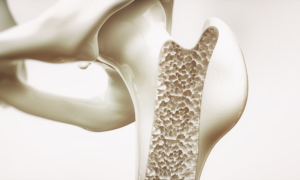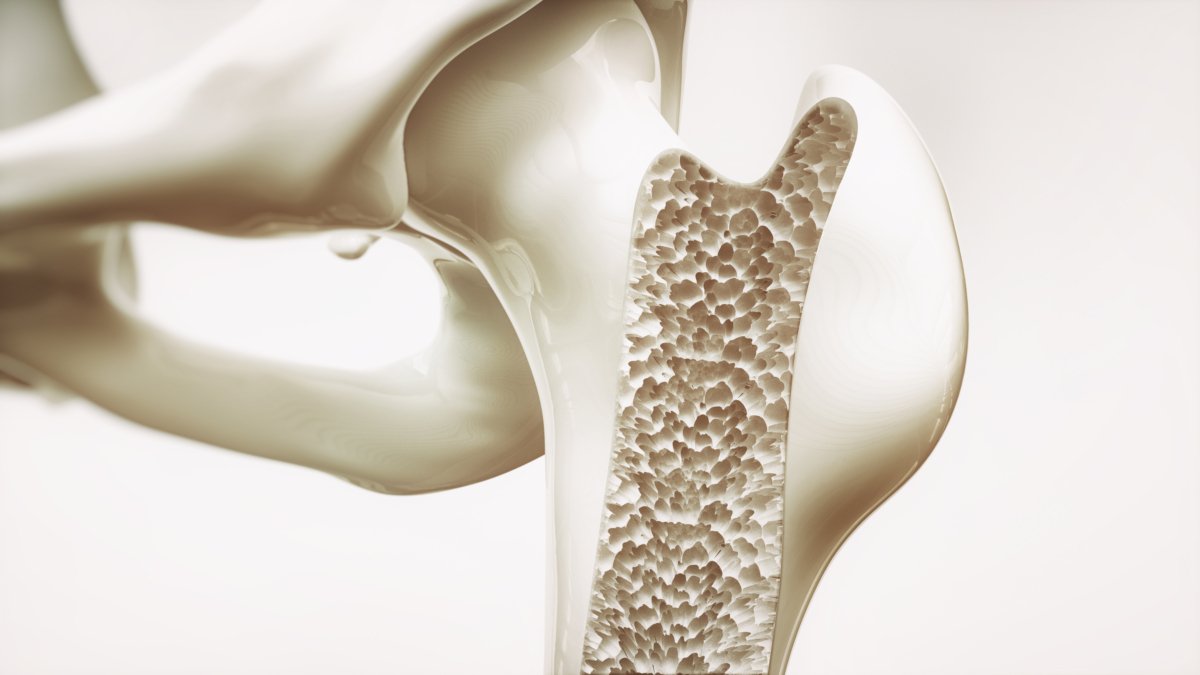A Functional Approach to Osteoporosis and Bone Health

Several factors can contribute to osteoporosis, and many of these are within your control. Rather than focus on one isolated deficiency or issue, it’s wise to consider your broader lifestyle for risk factors and take steps to prevent the osteoporosis.
For example, systemic inflammation is a primary driver of osteoporosis. If there is chronic, systemic inflammation throughout the body, bone remodeling is inhibited, contributing to the development of osteoporosis. Ongoing inflammation can arise from several factors, ranging from diet to stress to environmental toxins.
Osteoporosis often presents in combination with another inflammatory condition, such as diabetes and rheumatoid arthritis. Essentially, chronic inflammation can lead to a chain reaction of conditions.
Osteoporosis leaves the bones weak and prone to fractures with low bone mineral density. This disease can develop with few obvious symptoms and now affects more than 10.2 million adults in the United States over the age of 50.
Risk Factors for Osteoporosis
Age
Women over the age of 50 account for the vast majority of osteoporosis diagnoses because of the hormonal changes women experience throughout the stages of menopause. However, men and younger women can also experience low bone density, most commonly found with hip injuries.
Standard American Diet
Consuming a diet high in simple carbohydrates, refined sugars, and processed foods will cause oxidative stress, triggering an immune system response. This leads to elevated levels of cortisol, causing bones to lose higher amounts of calcium.
Sedentary Lifestyle
As a person ages, they will naturally experience sarcopenia, a loss of muscle mass. This loss of muscle mass is often to blame for falls and bone-related injuries that occur with age. Living an active lifestyle is imperative to fighting this natural biological response. Being sedentary leads to increased bone density reduction and general weakness. Physical activity stresses the bones and spurs them to grow stronger.
Chronic Stress
Stress is to blame for so many physical challenges, and osteoporosis is no exception. Stress can cause a reduction in the amount of stomach acid produced, so the body is not able to properly digest and use the necessary nutrients and minerals that bones require.
In addition, stress causes immune suppression. This can inhibit the body’s ability to use calcium to fight against the inflammation. The body will find a way to access calcium if it’s under stress, and if it can’t find it elsewhere, it will pull calcium from the bones.
Another effect of chronic stress is elevated levels of the stress hormone cortisol. This causes the body to deposit calcium into urine rather than into the bones, where it should go.
Leaky Gut
Leaky gut is often a significant contributing factor to chronic inflammation. As mentioned earlier, systemic inflammation can lead to malabsorption, causing bone resorption as the body seeks to find the vital minerals it needs to thrive.
Food Sensitivities, Gluten Sensitivity, or Celiac Disease
Whether someone is dealing with a food sensitivity, gluten sensitivity, or celiac disease (an autoimmune disease), consuming foods the body has a reaction to is going to trigger inflammation. The body sees these foods as a threat and tries to fight them off.
Environmental Toxin Exposure
Another leading cause of systemic inflammation is carrying a high toxic load. Most individuals across the globe come into a wide variety of toxins every day, whether from lead, aluminum, and other heavy metals or from endocrine-disrupting chemicals found in conventional hygiene products such as body wash, shampoo, and shaving cream. Other sources of toxins are plastics, alcohol, tobacco, mold, and a variety of pesticides.
How to Diagnose Osteoporosis
The most common method of assessing bone mineral density is through dual-energy X-ray absorptiometry (DEXA). This method uses low amounts of radiation to measure the solidity of bones such as the hip, wrist, and spine. This test is generally recommended for women over the age of 65, though the DEXA scan is often performed on women or men who have risk factors for osteoporosis.
The DEXA scan assesses the bones and scores them based on a comparison with the healthy bones of a 30-year-old person. These results are given in a t-score, with anything greater than -1 considered to be “normal.”
An individual showing early signs of bone loss will usually have a t-score between -1 and -2.5, and scores lower than -2.5 are more likely to be diagnosed as osteoporosis.
However, there are some exceptions. Many women naturally have lower bone density and can naturally have a -3.5 t-score; for some women, this is absolutely normal and should not be an automatic point for concern or automatic diagnosis and treatment.
If an individual receives a score of -4.0 or worse, they are considered to be under a significant risk of bone fracture. If a score like this is given, a provider’s main focus should be getting them out of trouble as quickly as possible. Sometimes medication is necessary while emphasizing nutrition and lifestyle.
Looking Deeper to Understand the Root Cause of Osteoporosis
Considering other inflammatory markers can be extremely helpful in identifying the root cause of osteoporosis.
C-Reactive Protein (CRP): Inflammation can be examined by testing for levels of CRP, which is produced by the liver. If the body is experiencing inflammation, the test results will show elevated CRP levels.
Ferritin: Testing ferritin levels in the blood shows how much iron the body is capable of storing. If ferritin levels are elevated, it can indicate a form of chronic inflammation.
Hormones: This is a common testing strategy for women going through one of the stages of menopause. As hormone levels (particularly progesterone and estrogen) fluctuate during these years, a woman’s bones can be directly affected as their bone absorption and mass is often directly affected by the changing hormone levels.
Gut Microbes: A comprehensive stool test can be helpful to identify any type of inflammation or gut dysbiosis.
Total Toxin Burden: This comprehensive test will produce a wealth of information about a variety of factors directly affecting bone health such as heavy metals, environmental toxins, and mycotoxins. This can be particularly helpful in making an informed game plan to begin healing the body.
The Functional Approach
Vitamin D: Vitamin D helps the body absorb calcium from food. It’s important to get adequate amounts of vitamin D from the sunshine each day and from vitamin D-rich foods such as wild-caught salmon, grass fed beef liver, sardines, and cod liver oil.
Magnesium: Magnesium is necessary if supplementing with vitamin D, as it converts vitamin D into an active form that the body can put to use.
Vitamin K2: Vitamin K2 activates osteocalcin so that calcium can bind to bones and stay out of the blood vessels.
Alpha-Lipoic Acid: Alpha-lipoic acid can be effective in lowering oxidative stress and systemic inflammation.
Berberine: Supplementing with berberine has been shown to be effective in lowering inflammation levels, helping to prevent bone loss.
Nutrient-Dense Food: Avoid processed foods, sugars, and simple carbohydrates that will not nourish the body sufficiently. Additionally, avoid any individual food sensitivities in an effort to lower inflammation levels. Eat whole foods.
Health Promoting Fats: Grass-fed butter, ghee, and tallow are good sources of vitamin A, D, and K2.
Omega-3 Fatty Acids: These are essential, and the body cannot produce them, so they must be consumed in the diet. Foods rich in omega-3 fatty acids include salmon, mackerel, herring, oysters, cod liver oil, and sardines. Nuts and seeds, including walnuts, flaxseed, and chia seeds, are also good sources of omega-3 fatty acids.
Protein: Consuming a diet with high levels of protein is necessary for preserving bone mineral density.
Exercise: Keep the body moving every day. Resistance exercise is shown to be particularly helpful for bone health. These exercises include jumping rope, hiking, high-intensity interval training, and strength training. Exercises that promote flexibility, such as yoga and Pilates, are also particularly helpful. Remaining active and strong will help to preserve bone health, muscle mass, stability, and balance, helping to lower the risk of falls and other common osteoporosis-related accidents and injuries.
Stress Management: There are many ways to lower stress levels, such as daily walks, breathing exercises, dancing, gardening, and journaling. Whatever the stress management method, it’s important to make it a daily routine to move the body out of a sustained state of fight or flight.
Reduce Toxic Load: While this can seem overwhelming, small, consistent changes have a significant effect on the body’s overall toxic burden. Avoiding processed foods, harsh cleaners, cigarettes, and other common chemicals will help. Remove personal hygiene products, candles, and laundry and dish detergents that include synthetic fragrances. Eat high-quality whole foods made and grown without preservatives or pesticides.
While osteoporosis is a disease that affects many adults as they age, there are lifestyle choices that can help prevent this and other common age-related ailments. It’s imperative to make a healthy lifestyle a priority. Consuming a nutrient-dense diet, living an active lifestyle, and keeping stress levels low whenever possible will all aid in preventing the onset of osteoporosis.




